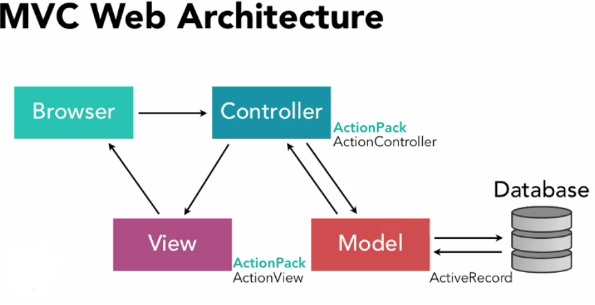
Ruby on Rails is a web framework in Ruby, following the MVC pattern. It promotes convention over configuration and don’t repeat yourself principles. Key components include Active Record for database interaction, Action Controller for data flow, and Action View for the user interface. The routing system maps URLs to controller actions, and scaffolding generates basic CRUD files. Rails embraces “Convention over Configuration” and “Don’t Repeat Yourself” to enhance developer productivity.
1. In Ruby, contrast the Controller, Views.
Ans:
Controller Responsibility: Handles incoming requests, processes them, and sends responses.
Example: UsersController with actions like index and show.
Views Responsibility: Presents data to the user.
Example: HTML/ERB files displaying user data.
2. How well defined is Ruby on Rails, and what specifics do you know about it?
Ans:
Ruby on Rails is a web application framework written in Ruby, following the MVC architecture and emphasizing Convention over Configuration and Don’t Repeat Yourself principles. It includes features like Active Record for database interaction, scaffolding for quick development, and a gem system for extending functionality. The framework promotes a RESTful design for building scalable applications.
3. What function does Ruby’s Active Record serve exactly?
Ans:
Active Record in Ruby simplifies database interactions by abstracting SQL queries, providing CRUD operations, validations, callbacks, and association management. It integrates seamlessly into the Model layer of the MVC architecture in Ruby on Rails, making database interactions more intuitive and object-oriented.
4. Could you list a few elements that have helped Ruby on Rails become successful or well-liked?
Ans:
Ruby on Rails’ success is attributed to its developer-friendly conventions like Convention over Configuration (CoC) and Don’t Repeat Yourself (DRY). The elegant Ruby syntax, powerful Active Record ORM, scaffolding for quick development, and a supportive community have also played crucial roles. Its emphasis on MVC architecture, RESTful design, and flexibility make it a preferred framework for rapid and scalable web application development.
5. What is the ERB in Ruby on Rails that you understand?
Ans:
ERB (Embedded Ruby): Templating system in Ruby on Rails.
File Extension: ERB templates typically have .html.erb or .xml.erb extensions.
Mixing Ruby with Markup: Allows embedding Ruby code within HTML, XML, or other markup languages.
6. What fundamental requirements should a user be aware of when creating an ERB document in Ruby?
Ans:
- File Extension: Typically .html.erb or .xml.erb.
- Tags: <% %> for code, <%= %> for code with output.
- Variables: Use defined variables, often @-prefixed.
- Control Flow: Employ <% %> for structures like if.
7. What has impressed you the most about Ruby on Rail thus far?
Ans:
Developers are often impressed by Ruby on Rails for its elegant syntax, strong conventions, rapid development capabilities, ActiveRecord for simplified database interactions, built-in testing support, and a vibrant community with a rich ecosystem of gems.
8. Tell me about the Ruby on Rails Action Controller.
Ans:
The Action Controller in Ruby on Rails manages incoming HTTP requests, processes them through actions defined in controller classes, and generates responses. It plays a key role in the MVC architecture, handling routing, parameters, filters, rendering views, session management, and HTTP responses. The controller is responsible for orchestrating the flow of data between models and views in a Rails application.

9. To what extent are you aware of the Active Records Rail?
Ans:
Active Record is the Object-Relational Mapping (ORM) component in Ruby on Rails. It facilitates database interactions by mapping database tables to Ruby objects (models), providing CRUD operations, associations, validations, callbacks, and a query interface. Active Record is a crucial part of Rails’ Model layer in the MVC architecture, offering a developer-friendly way to interact with databases using Ruby code.
10. What do the Ruby’s harnesses and fixtures actually mean?
Ans:
Test Harness: It refers to the testing framework, such as Minitest or RSpec, providing the structure for writing, organizing, and executing tests.
Fixtures: Fixtures are predefined data loaded into the database before tests, ensuring consistent and predictable conditions for testing application behavior. They are defined in YAML files.
11. Which three environments are default for Rails?
Ans:
Development: Used for local coding and testing with detailed error messages and code reloading.
Test: Specifically for automated testing to ensure application functionality.
Production: Live environment for end-users, optimized for performance and security, with minimal error messages and optimizations.
12. What is Ruby on Rails?
Ans:
Ruby on Rails is a web application framework written in Ruby that follows the Model-View-Controller (MVC) architecture. It provides a set of conventions for rapid development, emphasizing convention over configuration, which allows developers to focus on writing code rather than dealing with boilerplate configurations.
13. Explain the MVC architecture in Ruby on Rails.
Ans:
MVC in Ruby on Rails separates an application into three components: Model (handles data and business logic), View (presents data to the user), and Controller (manages user input and interacts with both Model and View). This separation enhances code organization, maintainability, and scalability.
14. What is ActiveRecord in Rails?
Ans:
ActiveRecord is Rails’ Object-Relational Mapping (ORM) framework. It simplifies database interactions by providing an abstraction layer between the application and the database, allowing developers to interact with the database using Ruby code instead of SQL queries directly.
15. Explain the difference between render and redirect_to in Rails.
Ans:
| Feature | render | redirect_to | |
| Purpose |
Renders a view template as part of the current request. |
Performs an HTTP redirect, instructing the browser to make a new request to a different URL. | |
| HTTP Status Code | Generally, returns a 200 OK status code. | Returns a 3xx status code (e.g., 302 Found) to indicate a redirect. | |
| View Rendering | Renders a specified view template. | Does not render a view; it redirects to a new URL. |
16. What is the purpose of the gemfile in a Rails application?
Ans:
The Gemfile is a configuration file in a Rails application that specifies the gems (libraries or packages) required for the project. It includes information about the gem names, versions, and sources. Running bundle install installs the specified gems and their dependencies.
17. Explain the concept of migrations in Rails.
Ans:
Migrations in Rails are a way to evolve the database schema over time. They allow developers to make changes to the database structure, such as creating or modifying tables, in a version-controlled manner. Migrations are created using the rails generate migration command and can be run with rails db:migrate.
18. What is the purpose of the Rails Asset Pipeline?
Ans:
The Asset Pipeline in Rails is a feature that processes and organizes the assets (JavaScript, CSS, images) of a Rails application. It helps improve performance by minimizing and compressing assets, and it also provides tools for managing asset dependencies and precompilation.
19. Differentiate between has_many and has_one associations in ActiveRecord.
Ans:
In ActiveRecord associations, has_many signifies a one-to-many relationship where one record in a model can be associated with multiple records in another model. On the other hand, has_one indicates a one-to-one relationship, where each record in a model is associated with at most one record in another model.
20. Explain the purpose of Rails migrations’ change method.
Ans:
The change method in Rails migrations is a convenient way to write migrations that can be applied both to upgrade and downgrade a database schema. It automatically detects the appropriate method (up or down) to use based on the current state of the database.
21. What is the role of the Rails router?
Ans:
Routing Requests: Matches incoming HTTP requests to specific controllers and actions.
RESTful Routes: Encourages RESTful design for creating, reading, updating, and deleting resources.
Resourceful Routing: Declares routes for a resource with a single line, generating standard RESTful routes.
22. What is RESTful routing in Rails?
Ans:
RESTful routing in Rails follows a convention for mapping HTTP verbs (GET, POST, PUT, DELETE) to CRUD actions (Create, Read, Update, Delete) on resources. It ensures a standardized and predictable way of defining routes and actions in a Rails application.
23. Explain the purpose of the Rails console.
Ans:
The Rails console, accessible via rails console or rails c, provides an interactive environment for running Ruby code within the context of a Rails application. It’s a powerful tool for testing code snippets, interacting with the database, and debugging.
24. Differentiate between Form_for and Form_tag in Rails views.
Ans:
Form_for is used for creating forms for a specific model, and it automatically generates form fields based on the model’s attributes. On the other hand, Form_tag is a more generic form helper for creating forms that are not necessarily tied to a model.
25. What is the purpose of Rails callbacks?
Ans:
Rails callbacks are methods that are triggered at specific points during the life cycle of an ActiveRecord object. They allow developers to execute code before or after certain operations, such as saving an object to the database or validating its attributes.
26. Explain the concept of “convention over configuration” in Rails.
Ans:
“Convention over configuration” is a guiding principle in Rails that emphasizes sensible defaults and conventions. It means that the framework makes assumptions about how things should be structured, reducing the need for explicit configuration when following those conventions.
27. How does Rails handle database migrations for different environments?
Ans:
Migration Files: Created using rails generate migration to define changes to the database schema.
Timestamps: Migration files are timestamped to ensure the correct sequence of application.
Migration Classes: Each migration file contains a class inheriting from ActiveRecord: Migration with methods defining schema changes.
28. What is the purpose of the Before_action and After_action filters in Rails controllers?
Ans:
Before_action and After_action filters allow developers to specify methods that should be executed before or after a controller action. These filters are useful for tasks like authentication checks, setting instance variables, or logging.
29. How does Rails support AJAX in views?
Ans:
Rails provides the remote: true option in form helpers, which enables the submission of forms via AJAX. Additionally, Rails UJS (Unobtrusive JavaScript) includes helpers like link_to and form_with that can be used with AJAX easily.
30. Explain the purpose of the respond_to block in Rails controllers.
Ans:
The respond_to block is used in Rails controllers to handle different types of HTTP requests (HTML, JSON, XML, etc.). It allows developers to specify different response formats based on the request type, ensuring the appropriate content is sent to the client.
31. What is the role of the seeds.rb file in Rails?
Ans:
Database Initialization: Seeds.rb in Rails is a file used for initializing the database with default or sample data.
Location: It is typically located in the db directory of a Rails project.
Data Population: The file contains Ruby code to create and populate records in the database tables.
32. How does Rails implement CSRF protection?
Ans:
Rails uses a CSRF token to protect against Cross-Site Request Forgery attacks. The token is embedded in forms, and Rails compares the token from the form submission with the token stored on the server to verify the authenticity of the request.
33. Explain the purpose of the Has_secure_password method in Rails models.
Ans:
Has_secure_password is a Rails method that adds methods to set and authenticate against a BCrypt password. It’s commonly used for handling user authentication securely, including password hashing.
34. What is the asset pipeline in Rails and how does it work?
Ans:
The asset pipeline in Rails processes and organizes assets (CSS, JavaScript, images) to improve performance. It involves asset compression, fingerprinting for cache-busting, and a logical structure for managing assets in the app/assets directory.
35. How does Rails support internationalization (I18n)?
Ans:
Configuration: Configuration settings in config/application.rb and locale-specific YAML files.
Locale Files: Translations organized in YAML files within config/locales.
Helpers: Helper methods like t and l for translating and formatting content.
Dynamic Content: Support for dynamic content and variable interpolation in translations.
36. Explain the concept of partials in Rails views.
Ans:
Partials in Rails are reusable view components that can be rendered within other views. They help in keeping views DRY (Don’t Repeat Yourself) by encapsulating and reusing common pieces of HTML or code.
37. What is the purpose of the rails routes command
Ans:
The rails routes command displays a list of all defined routes in a Rails application. It provides a helpful overview of the application’s routing configuration, including HTTP methods, URIs, and associated controller actions.
38. How does Rails handle sessions?
Ans:
Rails uses cookies to store session data on the client side. The session data is encrypted before being sent to the client, ensuring data integrity and security. The encrypted session data is then decrypted on subsequent requests.
39. Explain the concept of eager loading in Rails and why it’s important.
Ans:
Eager loading in Rails refers to the loading of associated records along with the main record in a single database query. It helps prevent the “N+1 query problem” by reducing the number of database queries needed to fetch associated data, improving performance.
40. What is the purpose of the rails db:rollback command?
Ans:
Database Reversion: rails db:rollback reverses the last applied database migration, undoing schema changes and data modifications.
Schema Restoration: The command updates the database schema to the state it was in before the last migration was executed.
41. How does Rails handle assets like images and stylesheets in views?
Ans:
Rails provides asset helpers like image_tag and stylesheet_link_tag to include images and stylesheets in views. These helpers automatically handle asset paths, making it easy to reference assets stored in the app/assets directory.
42. Explain the concept of a “callback chain” in Rails.
Ans:
In Rails, a callback chain is a series of methods that are executed in a specific order during the life cycle of an ActiveRecord object. Callbacks allow developers to hook into various stages of an object’s life cycle, such as before or after validation or saving.
43. What is the purpose of the rails generate command in Rails?
Ans:
The rails generate command, often shortened to rails g, is used to generate various components of a Rails application, such as models, controllers, migrations, and more. It follows conventions to create files and code based on specified generators.
44. How does Rails implement the Single Table Inheritance (STI) pattern?
Ans:
Rails supports Single Table Inheritance, where different types of objects are stored in a single database table. The type column is used to store the class name, allowing ActiveRecord to instantiate the appropriate Ruby class when fetching records.
45. What is the purpose of the Rails params hash?
Ans:
Access Request Data: Retrieve data from form submissions, URL parameters, and other client-side requests.
Form Data Handling: Process user-submitted form input values in controllers.
URL Parameter Access: Access parameters included in the URL for dynamic content handling.
46. Explain the difference between render and redirect_to in Rails controllers.
Ans:
render is used to render a view template within the current request, while redirect_to is used to send an HTTP redirect status code and direct the browser to a different URL. render is suitable for rendering views as part of the current request, while redirect_to is used for actions that should result in a new HTTP request.
47. How does Rails handle database transactions, and why are they important?
Ans:
Rails uses database transactions to ensure data integrity. Transactions wrap a series of database operations, committing all changes if successful and rolling back if any part fails. This ensures that the database is always in a consistent state.
48. What is the purpose of the Rails Asset Pipeline and how does it improve performance?
Ans:
The Asset Pipeline in Rails processes and organizes assets like JavaScript, CSS, and images to improve performance. It involves tasks such as minification, compression, and fingerprinting for cache-busting, reducing file sizes and improving load times.
49. Explain the difference between belongs_to and has_one associations in ActiveRecord models.
Ans:
In ActiveRecord associations, belongs_to signifies a one-to-many relationship where one record in a model is associated with exactly one record in another model. On the other hand, has_one indicates a one-to-one relationship, where each record in a model is associated with at most one record in another model.50. What is the purpose of the rails db:seed command?
Ans:
- rails db:seed is a command in Ruby on Rails used to insert predefined data into the database.
- It executes the code specified in the seeds.rb file, which is located within the db directory of a Rails application.
- Developers utilize this functionality to populate the database with default or sample records required for application setup or testing purposes.
51. Explain the concept of Rails Concerns.
Ans:
Rails Concerns are a way to group reusable code in modules and include them in models or controllers. They promote code organization and maintainability by encapsulating related functionality in separate modules.
52. What is the purpose of the validates method in Rails models?
Ans:
The validates method in Rails models is used to define validation rules for model attributes. It allows developers to specify conditions that must be met for an object to be considered valid before saving it to the database.
53. How does Rails support nested resources in routing?
Ans:
Rails allows the definition of nested resources in routes, reflecting associations between models. This results in routes that include the parent resource, enabling the creation of RESTful URLs that represent hierarchical relationships between models.
54. Explain the role of the has_and_belongs_to_many association in ActiveRecord.
Ans:
Many-to-Many Relationship: has_and_belongs_to_many in ActiveRecord is used to define a many-to-many association between two models in a Rails application.
No Separate Model: Unlike other associations, it doesn’t require an explicit model for the join table, simplifying the setup for a direct relationship between models.
55. What is the purpose of the Rails application.html.erb layout file?
Ans:
The application.html.erb layout file in Rails serves as the main template for rendering views. It typically includes the common structure, headers, footers, and JavaScript/CSS references that are shared across multiple pages in the application.
56. Explain the role of the gemfile.lock file in a Rails project.
Ans:
The Gemfile.lock file in a Rails project specifies the exact versions of each gem and its dependencies that are currently installed. It ensures that all developers working on the project are using the same gem versions, providing consistency across environments.
57. How does Rails handle asset precompilation for production?
Ans:
In production, Rails precompiles and minifies assets to improve performance. The rake assets:precompile task generates compressed and fingerprinted versions of assets, allowing for efficient caching and faster loading times in a production environment.
58. What is the purpose of the before_save callback in Rails models?
Ans:
Timing of Execution: The before_save callback in Rails models triggers custom logic just before an object is saved to the database, regardless of whether it’s a new record being created or an existing one being updated.
Data Manipulation: It provides a way to modify attributes or perform calculations on the object’s data before it gets saved into the database.
59. Explain the concept of “fat models, skinny controllers” in Rails.
Ans:
“Fat models, skinny controllers” is a design principle in Rails that encourages placing business logic and data-related code in the model layer, keeping controllers lightweight. This approach enhances code organization, maintainability, and testability.
60. What is the purpose of the Rails link_to helper
Ans:
The link_to helper in Rails generates HTML links based on the provided parameters. It simplifies the creation of hyperlinks and is commonly used in views to generate links to other pages, resources, or actions within the application.
61. How does Rails support testing, and what is the role of fixtures and factories?
Ans:
Rails supports testing through tools like MiniTest or RSpec. Fixtures and factories are used to create test data. Fixtures are predefined data in YAML files, while factories (using tools like FactoryBot) provide a more flexible and dynamic way to generate test data.
62. What is the purpose of the rails db:schema:load command?
Ans:
Schema Loading: The rails db:schema:load command loads and recreates the database schema defined in the schema.rb file within the Rails application.
Initialization: It’s commonly used during the initial setup of a new application to initialize or reset the database structure based on the schema definitions without executing individual migrations.
63. Explain the concept of CSRF (Cross-Site Request Forgery) protection in Rails.
Ans:
CSRF protection in Rails involves the use of a unique token embedded in forms. This token is verified on the server side when the form is submitted, preventing malicious websites from making unauthorized requests on behalf of a user.
64. How does Rails implement caching, and what are the different types of caching?
Ans:
Rails supports caching at various levels, including view caching, action caching, and fragment caching. View caching stores the entire rendered HTML of a view, action caching caches the entire response of a controller action, and fragment caching caches specific parts of a view.
65. What is the purpose of the rails db:rollback command in the context of database migrations?
Ans:
Reverting Migrations: rails db:rollback reverses the effects of the most recently applied migration by executing the down method defined in the migration file.
Incremental Rollback: By default, it rolls back only the last migration. However, it allows specifying a STEP parameter to revert a specific number of recent migrations (rails db:rollback STEP=n).
66. Explain the concept of the inverse_of option in Rails associations.
Ans:
The inverse_of option in Rails associations helps ActiveRecord maintain the proper bidirectional relationships between associated objects. It ensures that when an object is associated with another, the association is reflected correctly on both sides.
67. What is the purpose of the respond_to block in Rails controllers, and how is it used?
Ans:
The respond_to block in Rails controllers is used to handle different types of HTTP requests (e.g., HTML, JSON, XML) and respond accordingly. It allows developers to specify different response formats based on the request type, ensuring proper content delivery.
68. Explain the role of the has_secure_token method in Rails models.
Ans:
The has_secure_token method in Rails is used to generate a unique and random token for a model attribute. It’s often employed for creating secure, random authentication tokens, such as for password reset links or API authentication.
69. What is the difference between delete and destroy?
Ans:
The environments directory in Rails contains configuration files for different application environments (development, test, production). Each environment file specifies settings, such as database connections and logging levels, that tailor the application behavior to the specific environment.
70. Explain the role of the rails db:migrate:status command in the context of database migrations.
Ans:
Migration Overview: rails db:migrate:status displays a summary of all migrations, indicating their status within the database—whether they are applied, pending, or reverted.
Applied Migrations: It lists migrations that have been successfully applied to the database, along with their version numbers and status (up).
71. How does Rails handle session management, and what is the purpose of the session hash?
Ans:
Rails manages sessions using cookies to store session data on the client side. The session hash in Rails controllers allows developers to store and retrieve session-specific information, providing a way to maintain state between requests for a particular user.
72. What is the purpose of the rails db:reset command, and when might it be used?
Ans:
The rails db:reset command resets the database by dropping and recreating it. It loads the schema and initializes the database with seed data specified in the db/seeds.rb file. It’s a convenient way to reset the database during development.
73. Compare ActiveRecord’s Has_many :through and Has_and_belongs_to_many associations.
Ans:
Has_many :through and has_and_belongs_to_many are both used to model many-to-many associations, but they have key differences. Has_many :through uses an intermediate model to represent the association, allowing additional attributes and methods. Has_and_belongs_to_many relies on a simple join table without an explicit model.
74. What does the config.time_zone setting do, and how does Rails handle time zones?
Ans:
Using the config.time_zone setting in the application.rb file, Rails developers can specify the default time zone for the application. This guarantees that the application handles time zones consistently, particularly when interacting with timestamps that are kept in the database.
75. What is the structure and purpose of the Rails config/routes.rb file?
Ans:
The application’s routes are defined in the Rails config/routes.rb file, which maps URLs to controller actions. It gives administrators a centralized and transparent method to manage the application’s routing by utilizing a DSL (Domain-Specific Language) to define routes, HTTP methods, and related controllers and actions.
76. Explain the concept of the Rails before_validation callback in models.
Ans:
Pre-Validation Action: The before_validation callback in Rails models executes custom logic automatically before the validation process when valid? or save methods are called.
Data Preparation: It’s utilized to preprocess or modify attributes within the object, ensuring data is formatted or set up correctly before validation rules are applied.
77. How does Rails handle form submissions and strong parameters in controllers?
Ans:
Rails controllers handle form submissions by accessing form data through the params hash. Strong parameters are used to whitelist and permit specific attributes for mass assignment, enhancing security by preventing unwanted parameters from being used to update records.
78. What is the purpose of the rails db:schema:dump command, and when might it be used?
Ans:
The rails db:schema:dump command generates a db/schema.rb file that represents the current state of the database schema. It’s useful in situations where a developer wants to share the application’s database structure or when using version control systems.
79. Define the role of current_user in Rails controllers for authentication.
Ans:
The current_user method is commonly used in Rails controllers to retrieve the currently authenticated user. It’s typically implemented in the application’s authentication system and allows controllers to access information about the logged-in user.
80. What particular pre-software needs must be met in order to develop a Ruby on Rails project?
Ans:
By and Rails Installation: Install Ruby and Rails using version managers like RVM or rbenv.
Database Setup: Choose and configure a relational database (e.g., PostgreSQL) for the Rails application.
Version Control System: Initialize a Git repository for version control and tracking code changes.
81. List databases compatible with Rails without issues.
Ans:
Ruby on Rails exhibits strong compatibility with databases like PostgreSQL, MySQL, and SQLite, making them popular choices. The ActiveRecord ORM simplifies integration, offering smooth interactions and reducing compatibility concerns. These databases are well-supported within the Rails framework, ensuring a reliable development experience.
82. What are the steps involved in installing Ruby on a Windows computer?
Ans:
Download and run the Ruby Installer from rubyinstaller.org.During installation, check “Add Ruby executables to your PATH.”Download and install the Development Kit from the same website.Open a command prompt, navigate to the DevKit directory, and run ruby dk.rb init and ruby dk.rb install.
83. What are the things you need to be aware of when writing the Rails application?
Ans:
Rails Conventions:Follow Rails conventions for structure and naming. RESTful Design:Embrace RESTful design for routes and controllers. Database Design:Plan the database schema, use migrations, and leverage ActiveRecord.
84. Give examples of a few Ruby directories and describe their functions.
Ans:
App Directory
Function: Primary application code.
Examples: App/controllers, app/models, app/views.
Config Directory
Function: Configuration files.
Examples: Config/routes.rb, config/database.yml.
85. Where can I find the Ruby controller classes that handle web requests?
Ans:
In a Ruby on Rails application, the controller classes that handle web requests are found in the app/controllers directory. Each controller file defines a class responsible for handling specific routes and contains methods (actions) that respond to different HTTP requests. For example, app/controllers/users_controller.rb might define a UsersController class for user-related actions.
86. What specific features are included in Ruby class libraries?
Ans:
Ruby class libraries include features for:
- Object-Oriented Programming (OOP).
- Collections and Iterators.
- File and I/O Operations.
- Regular Expressions.
87. What does Ruby on Rails’ object relationship model entail?
Ans:
Ruby on Rails’ object relationship model centers around ActiveRecord, the built-in ORM. It adheres to the MVC architecture, where models represent data, views handle presentation, and controllers manage interactions. ActiveRecord abstracts database operations, providing associations, validations, and callbacks. Migrations evolve the database schema, and a rich query interface enables easy data retrieval.
88. What does Ruby on Rails garbage collection entail?
Ans:
In Ruby on Rails, garbage collection is an automatic process managed by Ruby’s built-in garbage collector. It uses a mark-and-sweep algorithm, reference counting, and a generational model to reclaim memory occupied by unreferenced objects. Developers can tune garbage collection parameters for optimization and use tools like ObjectSpace and GC::Profiler for memory profiling.
89. In what way can the ruby’s symbols be distinguished from its variables?
Ans:
Ruby symbols start with a colon and are immutable, memory-efficient identifiers (e.g., :symbol). Variables start with a lowercase letter or underscore, are mutable, and store changing values (e.g., variable). Symbols are often used as keys, and their comparison is based on identity, not content.
90. Explain the concept of N+1 queries in the context of ActiveRecord and how to mitigate them.
Ans:
The N+1 query problem in ActiveRecord occurs when retrieving a collection of records with associated records, leading to additional queries. To mitigate, use the includes or eager_load method to preload associations in a single query and avoid the performance issue.






